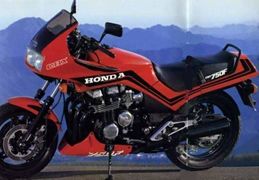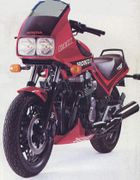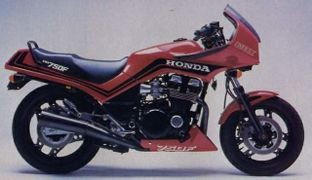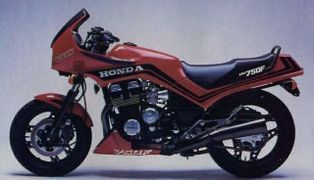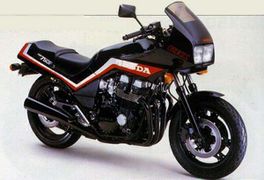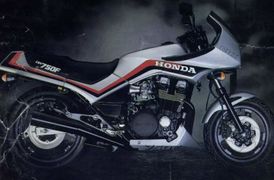Difference between revisions of "Honda CBX750F"
(upgrading template) |
(template fixes) |
||
| (7 intermediate revisions by 3 users not shown) | |||
| Line 1: | Line 1: | ||
{{Motorcycle | {{Motorcycle | ||
|name = | |name = Honda CB750 | ||
|photo=Honda-CBX750--2.jpg | |photo=Honda-CBX750--2.jpg | ||
|aka = | |aka = | ||
|manufacturer = Honda | |manufacturer = Honda | ||
|parent_company = | |parent_company = | ||
| Line 9: | Line 9: | ||
|predecessor = | |predecessor = | ||
|successor = | |successor = | ||
|class = | |class = Sport Bike | ||
|engine = | |engine = Air cooled, four stroke, transverse four cylinders | ||
|bore_stroke = | |bore_stroke = 66.0mm x 66.0mm | ||
|compression = 9.3:1 | |compression = 9.3:1 | ||
|top_speed = 131 mph | |top_speed = 131 mph | ||
|power = | |power = 93.07 HP (69.4 KW) @ 9500RPM | ||
|torque = | |torque = 52.37 ft/lbs (71.0 Nm) @ 8500RPM | ||
|fuel_system = | |fuel_system = Carburetor | ||
|ignition = Full transistor | |ignition = Full transistor | ||
|spark_plug = | |spark_plug = | ||
| Line 28: | Line 28: | ||
|rear_tire = {{tire|130/80-V18 Tubeless}} | |rear_tire = {{tire|130/80-V18 Tubeless}} | ||
|rake_trail = | |rake_trail = | ||
|wheelbase = | |wheelbase = 57.72 inches (1466 mm) | ||
|length = | |length = 84.41 inches (2144 mm) | ||
|width = | |width = 29.09 inches (739 mm) | ||
|height = | |height = | ||
|seat_height = | |seat_height = 31.3 inches (795 mm) | ||
|dry_weight = 215 kg / 474 lbs | |dry_weight = 215 kg / 474 lbs | ||
|wet_weight = 241 kg / 531.3 lbs | |wet_weight = 241 kg / 531.3 lbs | ||
|fuel_capacity = 22 liters / 5.8 US gal | |fuel_capacity = 22 liters / 5.8 US gal | ||
|oil_capacity = | |oil_capacity = | ||
|recommended_oil=Honda GN4 10W-40 | |||
|fuel_consumption = | |fuel_consumption = | ||
|turning_radius = | |turning_radius = | ||
| Line 42: | Line 43: | ||
|competition = | |competition = | ||
}} | }} | ||
The '''[[Honda]] CBX 750F''' was a Air cooled, four stroke, transverse four cylinders Sport Bike [[motorcycle]] produced by [[Honda]] in 1983. Max [[torque]] was 52.37 ft/lbs (71.0 Nm) @ 8500 RPM. Claimed [[horsepower]] was 93.07 HP (69.4 KW) @ 9500 RPM. It could reach a top speed of 131 mph. | |||
It could reach a top speed of 131 mph. | |||
==Engine== | ==Engine== | ||
| Line 54: | Line 54: | ||
It came with a 110/90-V16 Tubeless front [[tire]] and a 130/80-V18 Tubeless rear tire. Stopping was achieved via 2x 280mm discs 2 piston calipers in the front and a Single 280mm disc 2 piston [[caliper]] in the rear. The front suspension was a 39mm Air assisted forks, rebound adjustable, while the rear was equipped with a Pro-link, 3-way rebound damping adjustable. The CBX750F was fitted with a 22 liters / 5.8 US gal fuel tank. The bike weighed just 215 kg / 474 lbs. | It came with a 110/90-V16 Tubeless front [[tire]] and a 130/80-V18 Tubeless rear tire. Stopping was achieved via 2x 280mm discs 2 piston calipers in the front and a Single 280mm disc 2 piston [[caliper]] in the rear. The front suspension was a 39mm Air assisted forks, rebound adjustable, while the rear was equipped with a Pro-link, 3-way rebound damping adjustable. The CBX750F was fitted with a 22 liters / 5.8 US gal fuel tank. The bike weighed just 215 kg / 474 lbs. | ||
== Photos == | == Photos == | ||
<gallery mode='packed-hover'> | |||
File:Honda-CBX750--2.jpg|600px|Honda CB750 | |||
File:Honda-CBX750.jpg|600px|Honda CB750 | |||
File:Honda-CBX750--5.jpg|600px|Honda CB750 | |||
File:Honda-CBX750--6.jpg|600px|Honda CB750 | |||
</gallery> | |||
==1983 - 1985 Honda CBX 750F== | |||
<gallery mode='packed-hover'> | |||
File:honda-cbx-750f-1983-1985-2.jpg|600px|1983 - 1985 Honda CBX 750F | |||
File:honda-cbx-750f-1983-1985-1.jpg|600px|1983 - 1985 Honda CBX 750F | |||
File:honda-cbx-750f-1983-1985-0.jpg|600px|1983 - 1985 Honda CBX 750F | |||
</gallery> | |||
The Honda CBX 750F model is a Sport bike manufactured by Honda. In this version sold from year 1983 , the dry weight is 218 Kg (480.6 pounds) and it is equiped with a In-line four, four-stroke motor. The engine produces a maximum peak output power of 93.00 HP (67.8 kW) @ 9500 RPM. With this drive-train, the Honda CBX 750F is capable of reaching a maximum top speed of 2182.0 km/h (113 mph). Regarding the chassis characteristics, responsible for road holding, handling behaviour and ride confort. Stock tire sizes are 110/90-16 on the front, and 130/80-18 on the rear. As for stopping power, the Honda CBX 750 F braking system includes Dual disc size 280 mm at the front and Single disc size 280 mm at the rear. | |||
== Overview == | |||
The release of the CBX marked the | The release of the CBX marked the | ||
end of 15 years of uninterrupted CB750/4 production, involving countless | end of 15 years of uninterrupted [[Honda CB750K|CB750/4]] production, involving countless | ||
revisions, new engines and updates. Honda were the first to launch an inline | revisions, new engines and updates. Honda were the first to launch an inline | ||
750/4 - the original superbike -back in 1969. It used a SOHC, eight valve | 750/4 - the original superbike -back in 1969. It used a SOHC, eight valve | ||
| Line 96: | Line 79: | ||
valve engine and produces 91bhp. | valve engine and produces 91bhp. | ||
The CBX differs from its many predecessors in some significant ways. The top end of the motor is remarkable for employing hydraulic tappets, hardly a new idea | |||
The CBX differs from its many | |||
predecessors in some significant ways. The top end of the motor is | |||
remarkable for employing hydraulic tappets, hardly a new idea | |||
(Harley-Davidson have used them for decades) but unique on a Japanese | (Harley-Davidson have used them for decades) but unique on a Japanese | ||
production motorcycle. The advantage to the owner in not having to set 16 | production motorcycle. The advantage to the owner in not having to set 16 | ||
| Line 110: | Line 85: | ||
valves making for less reciprocating weight. | valves making for less reciprocating weight. | ||
Weight saving and compact design are in evidence everywhere on the engine. Its width was reduced by placing the big 320W alternator behind the cylinders instead of spinning on the crank end. Height was reduced by making the sump shallower and redeploying | |||
Weight saving and compact design | |||
are in evidence everywhere on the engine. Its width was reduced by placing | |||
the big 320W alternator behind the cylinders instead of spinning on the | |||
crank end. Height was reduced by making the sump shallower and redeploying | |||
the front frame tubes as oil carriers, a novel redistribution that actually | the front frame tubes as oil carriers, a novel redistribution that actually | ||
increases the total oil capacity. Finally, Honda pruned the engine length by | increases the total oil capacity. Finally, Honda pruned the engine length by | ||
| Line 124: | Line 91: | ||
direct gear from the crank; one of the crank webs has been turned into a | direct gear from the crank; one of the crank webs has been turned into a | ||
gear pinion. | gear pinion. | ||
Engine performance is marked by | Engine performance is marked by | ||
smoothness and excellent tractability. The CBX makes good low-down power | smoothness and excellent tractability. The CBX makes good low-down power | ||
| Line 135: | Line 103: | ||
roadholding are exceptionally good for a bike of this size and weight. | roadholding are exceptionally good for a bike of this size and weight. | ||
The CBX is genuinely flickable, largely because of its low frontal area and careful weight distribution | |||
The CBX is genuinely flickable, | |||
largely because of its low frontal area and careful weight distribution | |||
(48.6/ 51.4 front and rear). It is stable up to top speed though the smart | (48.6/ 51.4 front and rear). It is stable up to top speed though the smart | ||
and sleek half-fairing is more of a sports cockpit than a touring | and sleek half-fairing is more of a sports cockpit than a touring | ||
windcheater. The dual headlights are a bonus for any road user, 120W of | windcheater. The dual headlights are a bonus for any road user, 120W of | ||
sharp illumination on dip or main beams. | sharp illumination on dip or main beams. The bike is a shade quicker and more powerful than the [[Honda VF750|V4 VF750]] which was also released early in 1984. | ||
and more powerful than the V4 VF750 which was also released early in 1984. | |||
In 1983, Honda replaces the [[Honda CB750F|Honda CB 750 FC]] by | |||
In 1983, Honda replaces the Honda CB 750 FC by | |||
a new model, CBX 750, even more oriented sport. This model comes in | a new model, CBX 750, even more oriented sport. This model comes in | ||
addition to the VF 750 S 4-cylinder V-giving birth to the line of VFR. | addition to the [[Honda VF750S|VF 750 S 4-cylinder]] V-giving birth to the line of VFR. | ||
The CBX 750 catches the eye with these wheels Comstar black, black engine, | The CBX 750 catches the eye with these wheels Comstar black, black engine, | ||
| Line 164: | Line 118: | ||
the VF 750. | the VF 750. | ||
Its engine is derived from the engine of CBX 650. In this engine, it | Its engine is derived from the engine of [[Honda CBX650|CBX 650]]. In this engine, it | ||
retains the dual cam shaft and four valves per cylinder. The displacement | retains the dual cam shaft and four valves per cylinder. The displacement | ||
of 750 cm3 was obtained by increasing the bore (from 60 to 67 mm) and a | of 750 cm3 was obtained by increasing the bore (from 60 to 67 mm) and a | ||
| Line 175: | Line 129: | ||
contributes to better oil cooling. | contributes to better oil cooling. | ||
Another typical engine | Another typical engine for its low maintenance. In addition to the | ||
electronic ignition, Honda has equipped the engine of a remedial hydraulic | electronic ignition, Honda has equipped the engine of a remedial hydraulic | ||
valve. | valve. | ||
| Line 184: | Line 138: | ||
If at its output, the machine could be classified among the 750 | If at its output, the machine could be classified among the 750 | ||
successful, Suzuki will dethrone quickly with his GSX R 750. To follow | successful, Suzuki will dethrone quickly with his [[Suzuki GSX-R750|GSX R 750]]. To follow this course to radicalization, Honda fate in 1985 CBX 750 F-II or [[Honda CB900F Bol D'or|Bol d'Or]], whose main developments concerning the replacement of the fairing Top of | ||
this course to radicalization, Honda fate in 1985 CBX 750 F-II or Bol d'Or, | |||
whose main developments concerning the replacement of the fairing Top of | |||
hoof and a full fairing, completely obscuring the engine. It will however | hoof and a full fairing, completely obscuring the engine. It will however | ||
be marketed until 1987. It was not until 1992 to see again a 4-cylinder | be marketed until 1987. It was not until 1992 to see again a 4-cylinder | ||
in-line 750 cm3: the Honda CB Seven Fifty. | in-line 750 cm3: the Honda CB Seven Fifty. | ||
==Specifications== | |||
{| class="wikitable" | {| class="wikitable" | ||
|- | |- | ||
| Line 297: | Line 247: | ||
|} | |} | ||
[[Category:Honda motorcycles]] | [[Category:Sport Bike motorcycles]] | ||
[[Category:Honda motorcycles|CBX750F]] | |||
[[Category:1980s motorcycles]] | |||
Latest revision as of 22:08, 23 November 2019
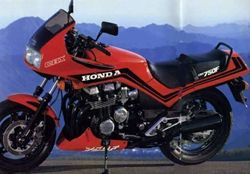 |
|
| Honda CB750 | |
| Manufacturer | |
|---|---|
| Production | 1983-84 |
| Class | Sport Bike |
| Engine | Air cooled, four stroke, transverse four cylinders |
| Bore / Stroke | 66.0mm x 66.0mm |
| Compression ratio | 9.3:1 |
| Top Speed | 131 mph |
| Horsepower | 93.07 HP (69.4 KW) @ 9500RPM |
| Torque | 52.37 ft/lbs (71.0 Nm) @ 8500RPM |
| Fuel System | Carburetor |
| Ignition | Full transistor |
| Transmission | 6 Speed |
| Frame | Tubular steel duplex cradle |
| Suspension | Front: 39mm Air assisted forks, rebound adjustable, Rear: Pro-link, 3-way rebound damping adjustable |
| Brakes | Front: 2x 280mm discs 2 piston calipers Rear: Single 280mm disc 2 piston caliper |
| Front Tire | 110/90-V16 Tubeless |
| Rear Tire | 130/80-V18 Tubeless |
| Wheelbase | 57.72 inches (1466 mm) |
| Length | 84.41 inches (2144 mm) |
| Width | 29.09 inches (739 mm) |
| Seat Height | 31.3 inches (795 mm) |
| Weight | 215 kg / 474 lbs (dry), 241 kg / 531.3 lbs (wet) |
| Recommended Oil | Honda GN4 10W-40 |
| Fuel Capacity | 22 liters / 5.8 US gal |
| Manuals | Service Manual |
The Honda CBX 750F was a Air cooled, four stroke, transverse four cylinders Sport Bike motorcycle produced by Honda in 1983. Max torque was 52.37 ft/lbs (71.0 Nm) @ 8500 RPM. Claimed horsepower was 93.07 HP (69.4 KW) @ 9500 RPM. It could reach a top speed of 131 mph.
Engine[edit | edit source]
The engine was a Air cooled cooled Four stroke, transverse four cylinders, DOHC, 4 valve per cylinder.. The engine featured a 9.3:1 compression ratio.
Drive[edit | edit source]
Power was moderated via the Wet multiplate.
Chassis[edit | edit source]
It came with a 110/90-V16 Tubeless front tire and a 130/80-V18 Tubeless rear tire. Stopping was achieved via 2x 280mm discs 2 piston calipers in the front and a Single 280mm disc 2 piston caliper in the rear. The front suspension was a 39mm Air assisted forks, rebound adjustable, while the rear was equipped with a Pro-link, 3-way rebound damping adjustable. The CBX750F was fitted with a 22 liters / 5.8 US gal fuel tank. The bike weighed just 215 kg / 474 lbs.
Photos[edit | edit source]
1983 - 1985 Honda CBX 750F[edit | edit source]
The Honda CBX 750F model is a Sport bike manufactured by Honda. In this version sold from year 1983 , the dry weight is 218 Kg (480.6 pounds) and it is equiped with a In-line four, four-stroke motor. The engine produces a maximum peak output power of 93.00 HP (67.8 kW) @ 9500 RPM. With this drive-train, the Honda CBX 750F is capable of reaching a maximum top speed of 2182.0 km/h (113 mph). Regarding the chassis characteristics, responsible for road holding, handling behaviour and ride confort. Stock tire sizes are 110/90-16 on the front, and 130/80-18 on the rear. As for stopping power, the Honda CBX 750 F braking system includes Dual disc size 280 mm at the front and Single disc size 280 mm at the rear.
Overview[edit | edit source]
The release of the CBX marked the end of 15 years of uninterrupted CB750/4 production, involving countless revisions, new engines and updates. Honda were the first to launch an inline 750/4 - the original superbike -back in 1969. It used a SOHC, eight valve engine and produced 67bhp. For comparison, the CBX750 features a DOHC, 16 valve engine and produces 91bhp.
The CBX differs from its many predecessors in some significant ways. The top end of the motor is remarkable for employing hydraulic tappets, hardly a new idea (Harley-Davidson have used them for decades) but unique on a Japanese production motorcycle. The advantage to the owner in not having to set 16 valve clearances is obvious. Honda have added thin-stemmed lightweight valves making for less reciprocating weight.
Weight saving and compact design are in evidence everywhere on the engine. Its width was reduced by placing the big 320W alternator behind the cylinders instead of spinning on the crank end. Height was reduced by making the sump shallower and redeploying the front frame tubes as oil carriers, a novel redistribution that actually increases the total oil capacity. Finally, Honda pruned the engine length by dispensing with the jackshaft between crank and clutch. Primary drive is by direct gear from the crank; one of the crank webs has been turned into a gear pinion.
Engine performance is marked by smoothness and excellent tractability. The CBX makes good low-down power aided by some low gearing. The mid-range is a bit flat and lacks snap but acceleration is very healthy at the top end, above 8,000rpm. The bike is so smooth and uncannily quiet at speed that Honda deemed it necessary to fit a rev limiter that cuts in at 10,800rpm. The engine's compactness means that it can be mounted lower in the frame, partially compensating for its inherent top heaviness. The steering is very quick, and handling and roadholding are exceptionally good for a bike of this size and weight.
The CBX is genuinely flickable, largely because of its low frontal area and careful weight distribution (48.6/ 51.4 front and rear). It is stable up to top speed though the smart and sleek half-fairing is more of a sports cockpit than a touring windcheater. The dual headlights are a bonus for any road user, 120W of sharp illumination on dip or main beams. The bike is a shade quicker and more powerful than the V4 VF750 which was also released early in 1984.
In 1983, Honda replaces the Honda CB 750 FC by a new model, CBX 750, even more oriented sport. This model comes in addition to the VF 750 S 4-cylinder V-giving birth to the line of VFR.
The CBX 750 catches the eye with these wheels Comstar black, black engine, its line of black and chrome exhaust (a four in both), its top fairing of his shoe, and his two square headlights. The line is similar to that of the VF 750.
Its engine is derived from the engine of CBX 650. In this engine, it retains the dual cam shaft and four valves per cylinder. The displacement of 750 cm3 was obtained by increasing the bore (from 60 to 67 mm) and a decrease in the race (from 58 to 53 mm). The carburetors have gone from 32 to 34 mm in diameter, but the compression ratio was reduced to 9,3:1. This engine is very compact with the postponement of the generator behind cylinder block. Also to have a more compact engine possible, the frame is used in part as a reservoir of oil. This has reduced the size of the oil sump and thus to install the engine very low in the frame, but also contributes to better oil cooling.
Another typical engine for its low maintenance. In addition to the electronic ignition, Honda has equipped the engine of a remedial hydraulic valve.
The finish is the machine is good. The scoreboard is integrated into the upper fairing and includes a counter, a tower, a voltmeter and a fuel gauge.
If at its output, the machine could be classified among the 750 successful, Suzuki will dethrone quickly with his GSX R 750. To follow this course to radicalization, Honda fate in 1985 CBX 750 F-II or Bol d'Or, whose main developments concerning the replacement of the fairing Top of hoof and a full fairing, completely obscuring the engine. It will however be marketed until 1987. It was not until 1992 to see again a 4-cylinder in-line 750 cm3: the Honda CB Seven Fifty.
Specifications[edit | edit source]
| Make Model | Honda CBX 750F |
|---|---|
| Year | 1983-84 |
| Engine Type | Four stroke, transverse four cylinders, DOHC, 4 valve per cylinder. |
| Displacement | 747 cc / 45.0 cu-in |
| Bore X Stroke | 67 x 53 mm |
| Cooling System | Air cooled |
| Compression | 9.3:1 |
| Induction | 4 x 34mm CV Type carbs |
| Ignition | Full transistor |
| Starting | Electric |
| Max Power | 93 hp / 67.8 kW @ 9500 rpm |
| Max Torque | 70.6 Nm / 52 lb-ft @ 8500 rpm |
| Clutch | Wet multiplate |
| Transmission | 6 Speed |
| Gear Ratio | 1st 3.00 2nd 2.235 3rd 1.750 4th 1.434 5th 1.240 6th 1.115 |
| Final Drive | Chain |
| Frame | Tubular steel duplex cradle |
| Front Suspension | 39mm Air assisted forks, rebound adjustable, |
| Front Wheel Travel | 150 mm / 5.9 in |
| Rear Suspension | Pro-link, 3-way rebound damping adjustable |
| Rear Wheel Travel | 115 mm / 4.5 in |
| Front Brakes | 2x 280mm discs 2 piston calipers |
| Rear Brakes | Single 280mm disc 2 piston caliper |
| Front Wheel | Six spoke Comstar |
| Rear Wheel | Six spoke Comstar |
| Front Tire | 110/90-V16 Tubeless |
| Rear Tire | 130/80-V18 Tubeless |
| Dry Weight | 215 kg / 474 lbs |
| Wet Weight | 241 kg / 531.3 lbs |
| Fuel Capacity | 22 liters / 5.8 US gal |
| Consumption Average | 34 mpg |
| Standing ¼ Mile | 12.1 sec / 111 mph |
| Top Speed | 131 mph |
